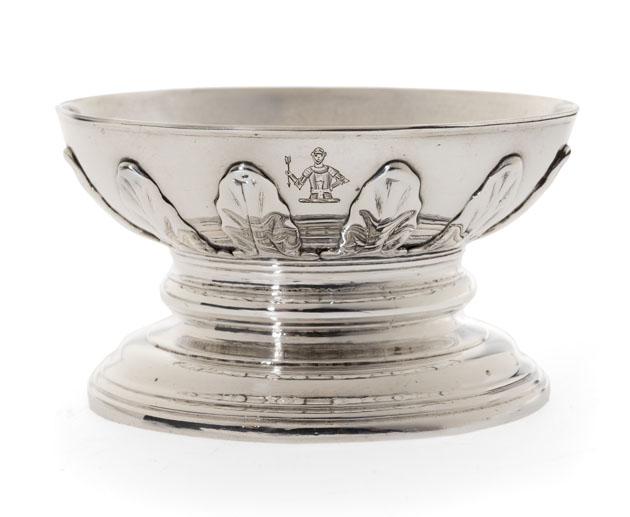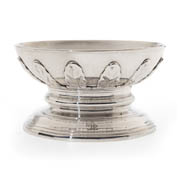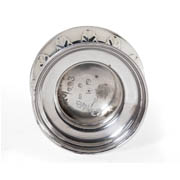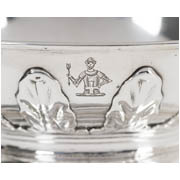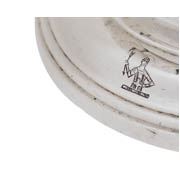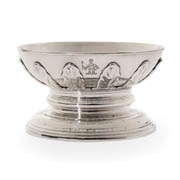Details
- Object type
salt
- Artist/Maker
Anne Tanqueray Silvermsith
- Place Associated
England, London (place of manufacture)
- Date
1726
- Materials
silver
- Dimensions
overall: 48 mm x 89 mm x 89 mm 190 g
- Description
-
A salt of silver bowl with leaves of cut card work on outside; reeded waist and spreading foot. Salt is marked with leopard's head crowned; lion passant guardant; date letter: capital Roman L; maker's mark: A T between sun burst and escallop (probably Anne Tanqueray). Engraved with half-figure of a man in armour holding in dexter (right) hand an arrow pointing downwards, the left hand placed on a large cross.
Place settings at an eighteenth century dining table would be laid with an individual salt for each diner, allowing them to sprinkle salt – probably with a spoon – onto their food. These were popular items and were commissioned regularly as silverware during the 18th century. This salt cellar bowl is decorated with leaves of cut card work. The bowl is engraved with the demi-figure of a man in armour holding in his right hand an arrow with his left hand on a cross. This engraving possibly may be the heraldic crest of the family the salt was created for or potentially added to the piece at a later date. The foliage decoration found on this piece was a common pattern used by 18th century Huguenot silversmiths to decorate of silverware.
This salt is probably stamped with the mark of silversmith, Anne Tanqueray who worked in London in the early 18th century. Anne, born in London 1691, was the eldest daughter of the Huguenot silversmith, David Willaume. Willaume had fled religious persecution from his native country of France after The Revocation of the Edict of Nantes in 1685. French Protestant craftsmen (Huguenots) settled in London seeking religious freedom and security. Huguenots brought with them knowledge and skills in the modelling, casting and engraving of silverware in the ‘International’ or ‘French’ style. By the late 17th century –early 18th century, high demand for this fashionable French silverware in England meant Huguenot silversmiths gathered commissions from wealthy patrons and were able to become ‘freemen’ of the Goldsmith Company, establishing workshops and taking on apprentices.
Anne married Willaume’s apprentice David Tanqueray in 1717 and probably worked in his workshop producing items of silverware. After David’s death (c.1724), Anne took over the running of the workshop under her name, registering her own mark into the Goldsmith Company’s records in 1724. David’s original registered mark from 1713 was scored out at this time with Anne’s name written above, showing she had taken over the management of the workshop. It was commonplace at the time for widows of silversmith craftsmen to take on the family business after their husband had died, giving them a unique position in society as both metalworkers and business owners. The workshop under Anne’s leadership continued to have an established and successful reputation with Anne becoming Subordinate Goldsmith to the King in 1729.
She died in Tingrith, Bedfordshire, in 1733. In her will, she left her ‘working tools’ and ‘patterns’ to the care of her executors to be given to her children, David and Thomas, when they came of age.
Other notable examples of her work are held in the Victoria and Albert Museum, London and National Museum Wales.
Provenance: Walter H. Wilson (dealer), from whom purchased by Sir William Burrell as a set of two salt trenchers (43.148-149) on 3 March 1928, for £94.10.0.
- Credit Line/Donor
Gifted by Sir William and Lady Burrell to the City of Glasgow, 1944
- Collection
Burrell Collection: Silverware
- ID Number
43.148
- Location
Burrell Collection
